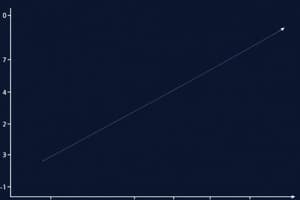Podcast
Questions and Answers
Which analysis ensures that an algorithm performs efficiently even in the best-case scenario?
Which analysis ensures that an algorithm performs efficiently even in the best-case scenario?
- Worst-case analysis
- Space complexity analysis
- Average-case analysis
- Best-case analysis (correct)
What aspect of an algorithm does space complexity analysis analyze?
What aspect of an algorithm does space complexity analysis analyze?
- Algorithm's performance
- Memory requirements (correct)
- Input size growth rate
- Number of computational steps
Which time complexity class represents an algorithm executing in time proportional to the logarithm of the input size?
Which time complexity class represents an algorithm executing in time proportional to the logarithm of the input size?
- $O(n)$
- $O(n^2)$
- $O(1)$
- $O(log n)$ (correct)
What does the Big O notation describe in terms of an algorithm's time complexity?
What does the Big O notation describe in terms of an algorithm's time complexity?
An algorithm with $O(n^2)$ time complexity executes in time proportional to:
An algorithm with $O(n^2)$ time complexity executes in time proportional to:
Which type of analysis deals with analyzing how an algorithm utilizes memory or auxiliary storage?
Which type of analysis deals with analyzing how an algorithm utilizes memory or auxiliary storage?
What does Big O notation describe in terms of algorithm efficiency?
What does Big O notation describe in terms of algorithm efficiency?
Which type of analysis ensures that an algorithm performs adequately even in the worst-case scenario?
Which type of analysis ensures that an algorithm performs adequately even in the worst-case scenario?
If an algorithm has a time complexity of O(n), what does this signify?
If an algorithm has a time complexity of O(n), what does this signify?
Which type of analysis provides an average performance guarantee for an algorithm?
Which type of analysis provides an average performance guarantee for an algorithm?
What does worst-case analysis focus on in terms of an algorithm's performance?
What does worst-case analysis focus on in terms of an algorithm's performance?
When discussing space complexity analysis, what aspect of an algorithm is being evaluated?
When discussing space complexity analysis, what aspect of an algorithm is being evaluated?
Flashcards are hidden until you start studying
Study Notes
Time Complexity: Breaking Down Algorithm Efficiency
When discussing the performance of algorithms, time complexity is a fundamental concept that helps us understand how well an algorithm scales up as the input size grows. This article will explore the central ideas of time complexity, focusing on Big O notation, worst-case analysis, average-case analysis, best-case analysis, and space complexity analysis.
Big O Notation
Big O notation, denoted as O(), is a widely-used tool in describing the upper bound of an algorithm's time complexity. It represents the growth rate of the number of operations an algorithm requires as its input size increases. For instance, an algorithm with time complexity O(n) means that the algorithm's execution time grows linearly with the input size n.
Worst-case analysis
Worst-case analysis refers to the scenario in which an algorithm's time complexity performs the worst for a given input. This analysis ensures that an algorithm performs adequately even in the worst-case scenario, giving us a worst-case guarantee of the algorithm's performance.
Average-case analysis
In contrast to worst-case analysis, average-case analysis takes into account the typical or average performance of an algorithm, as opposed to its worst performance. This analysis provides an average performance guarantee, which is a more practical measure of algorithm efficiency.
Best-case analysis
Best-case analysis examines the scenario in which an algorithm performs the best for a given input. This analysis ensures that an algorithm performs efficiently even in the best-case scenario, providing a best-case guarantee of the algorithm's performance.
Space complexity analysis
While time complexity deals with the number of computational steps an algorithm requires, space complexity analyzes the amount of memory or auxiliary storage an algorithm uses. Space complexity can be analyzed in a similar fashion to time complexity, using techniques such as Big O notation to describe the upper bound of an algorithm's memory requirements.
Understanding Time Complexity Classes
Time complexity classes are commonly used to categorize algorithms based on their growth rates. Some of the most common time complexity classes are:
- O(1): This class represents a constant time complexity. An algorithm with this time complexity will execute in constant time, regardless of the input size.
- O(log n): This class represents a logarithmic time complexity. An algorithm with this time complexity will execute in time proportional to the logarithm of the input size.
- O(n): This class represents a linear time complexity. An algorithm with this time complexity will execute in time proportional to the input size.
- O(n log n): This class represents a log-linear time complexity. An algorithm with this time complexity will execute in time proportional to the product of the input size and the logarithm of the input size.
- O(n^2): This class represents a quadratic time complexity. An algorithm with this time complexity will execute in time proportional to the square of the input size.
Understanding the time complexity classes and their implications can help software developers make informed decisions when selecting algorithms to solve specific problems.
In summary, time complexity is an essential concept in the world of algorithms, helping us understand how well an algorithm scales up as the input size grows. By analyzing time complexity from various perspectives, such as Big O notation, worst-case analysis, average-case analysis, best-case analysis, and space complexity analysis, we can make informed decisions about the suitability of algorithms for specific applications.
Studying That Suits You
Use AI to generate personalized quizzes and flashcards to suit your learning preferences.




